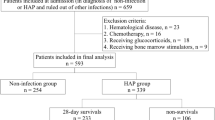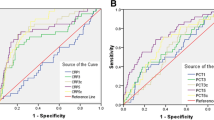Abstract
The aim of the present study is to evaluate the usefulness of two biomarkers—procalcitonin (PCT) and C-reactive protein (CRP)—in addition to the CURB-65 score for assessing the site of care and the etiology of non-severe community-acquired pneumonia (CAP). We conducted a prospective observational study from April 1, 2006, to June 30, 2007, in a single teaching hospital in northern Spain among patients with non-severe CAP. In addition to collecting data needed to determine the CURB-65 score, microbial cultures were taken and levels of PCT and CRP were measured. We compared the prognostic accuracy of these biomarkers with the CURB-65 score to predict hospitalization and microbial etiology using receiver operating characteristic (ROC) curves. A total of 344 patients with non-severe CAP were enrolled; 73 were admitted to the hospital and 271 were treated on an outpatient basis. An etiologic diagnostic was made for 44 %, with atypical pathogens predominating. Levels of PCT and CRP increased with increasing CURB-65 scores. Patients admitted to the hospital had higher PCT and CRP levels than outpatients (p < 0.001). For predicting hospitalization, PCT had a better area under the ROC curve (AUC) (0.81) than the CURB-65 score alone (0.77). For PCT plus the CURB-65 score, the AUC increased significantly from 0.77 to 0.83. In patients with bacterial CAP, the biomarker levels were significantly higher than among patients with atypical or viral etiology (p < 0.001). PCT with a cut-off point of 0.15 ng/mL was the best predictor for bacterial etiology and for select patients eligible for outpatient care. In conclusion, levels of PCT and CRP positively correlate with increasing severity of CAP and may have a role in predicting both patients who can safely receive outpatient care and the microbial etiology in patients with low CURB-65 scores.

Similar content being viewed by others
References
Lim WS, Woodhead M; British Thoracic Society (2011) British Thoracic Society adult community acquired pneumonia audit 2009/10. Thorax 66(6):548–549
Welte T, Torres A, Nathwani D (2010) Clinical and economic burden of community-acquired pneumonia among adults in Europe. Thorax 67(1):71–79
Marrie TJ (1994) Community-acquired pneumonia. Clin Infect Dis 18:501–515
Gleason PP, Kapoor WN, Stone RA et al (1997) Medical outcomes and antimicrobial costs with the use of the American Thoracic Society guidelines for outpatients with community-acquired pneumonia. JAMA 278:32–39
Lim WS, van der Eerden MM, Laing R et al (2003) Defining community acquired pneumonia severity on presentation to hospital: an international derivation and validation study. Thorax 58:377–382
Carratalà J, Fernández-Sabé N, Ortega L et al (2005) Outpatient care compared with hospitalization for community-acquired pneumonia: a randomized trial in low-risk patients. Ann Intern Med 142:165–172
España PP, Capelastegui A, Quintana JM et al (2003) A prediction rule to identify allocation of inpatient care in community-acquired pneumonia. Eur Respir J 21(4):695–701
Atlas SJ, Benzer TI, Borowsky LH et al (1998) Safely increasing the proportion of patients with community-acquired pneumonia treated as outpatients: an interventional trial. Arch Intern Med 158:1350–1356
Marrie TJ, Lau CY, Wheeler SL et al (2000) A controlled trial of a critical pathway for treatment of community-acquired pneumonia. CAPITAL Study Investigators. Community-Acquired Pneumonia Intervention Trial Assessing Levofloxacin. JAMA 283:749–755
Chalmers JD, Akram AR, Hill AT (2011) Increasing outpatient treatment of mild community-acquired pneumonia: systematic review and meta-analysis. Eur Respir J 37(4):858–864
Labarere J, Stone RA, Obrosky DS et al (2007) Comparison of outcomes for low-risk outpatients and inpatients with pneumonia: a propensity-adjusted analysis. Chest 131(2):480–488
Brown JS (2009) Biomarkers and community-acquired pneumonia. Thorax 64:556–558
Christ-Crain M, Opal SM (2010) Clinical review: the role of biomarkers in the diagnosis and management of community-acquired pneumonia. Crit Care 14:203
Halm EA, Teirstein AS (2002) Clinical practice. Management of community-acquired pneumonia. N Engl J Med 347:2039–2045
Menéndez R, Torres A, Aspa J et al (2010) Neumonía adquirida en la comunidad. Nueva normativa de la Sociedad de Neumología y Cirugía Torácica (SEPAR). Arch Bronconeumol 46(10):543–558
Lim WS, Baudouin SV, George RC; Pneumonia Guidelines Committee of the BTS Standards of Care Committee et al (2009) BTS guidelines for the management of community acquired pneumonia in adults: update 2009. Thorax 64(Suppl 3):iii1–iii55
Mandell LA, Wunderink RG, Anzueto A; Infectious Diseases Society of America; American Thoracic Society et al (2007) Infectious Diseases Society of America/American Thoracic Society consensus guidelines on the management of community-acquired pneumonia in adults. Clin Infect Dis 44(Suppl 2):S27–S72
Chalmers JD, Singanayagam A, Akram AR et al (2011) Safety and efficacy of CURB65-guided antibiotic therapy in community-acquired pneumonia. J Antimicrob Chemother 66(2):416–423
Flanders SA, Stein J, Shochat G et al (2004) Performance of a bedside C-reactive protein test in the diagnosis of community-acquired pneumonia in adults with acute cough. Am J Med 116(8):529–535
Simon L, Gauvin F, Amre DK et al (2004) Serum procalcitonin and C-reactive protein levels as markers of bacterial infection: a systematic review and meta-analysis. Clin Infect Dis 39(2):206–217
Gilbert DN (2010) Use of plasma procalcitonin levels as an adjunct to clinical microbiology. J Clin Microbiol 48:2325–2329
Gilbert DN (2011) Procalcitonin as a biomarker in respiratory tract infection. Clinic Infect Dis 52(Suppl 4):S346–S350
Masiá M, Gutiérrez F, Shum C et al (2005) Usefulness of procalcitonin levels in community-acquired pneumonia according to the patients outcome research team pneumonia severity index. Chest 128(4):2223–2229
Prat C, Domínguez J, Andreo F et al (2006) Procalcitonin and neopterin correlation with aetiology and severity of pneumonia. J Infect 52(3):169–177
Schuetz P, Batschwaroff M, Dusemund F et al (2010) Effectiveness of a procalcitonin algorithm to guide antibiotic therapy in respiratory tract infections outside of study conditions: a post-study survey. Eur J Clin Microbiol Infect Dis 29(3):269–277
Capelastegui A, España PP, Bilbao A; Poblational Study of Pneumonia (PSoP) Group et al (2010) Study of community-acquired pneumonia: incidence, patterns of care, and outcomes in primary and hospital care. J Infect 61(5):364–371
Hanley JA, McNeil BJ (1982) The meaning and use of the area under a receiver operating characteristic (ROC) curve. Radiology 143:29–36
Hanley JA, McNeil BJ (1983) A method of comparing the areas under receiver operating characteristic curves derived from the same cases. Radiology 148:839–843
Ewig S, Ruiz M, Mensa J et al (1998) Severe community-acquired pneumonia. Assessment of severity criteria. Am J Respir Crit Care Med 158:1102–1108
Fine MJ, Auble TE, Yealy DM et al (1997) A prediction rule to identify low-risk patients with community-acquired pneumonia. N Engl J Med 336:243–250
España PP, Capelastegui A, Gorordo I et al (2006) Development and validation of a clinical prediction rule for severe community-acquired pneumonia. Am J Respir Crit Care Med 174:1249–1256
Aliberti S, Ramirez J, Cosentini R et al (2011) Low CURB-65 is of limited value in deciding discharge of patients with community-acquired pneumonia. Respir Med 105(11):1732–1738
Ronan D, Nathwani D, Davey P et al (2010) Predicting mortality in patients with community-acquired pneumonia and low CURB-65 scores. Eur J Clin Microbiol Infect Dis 29(9):1117–1124
Blasi F, Stolz D, Piffer F (2010) Biomarkers in lower respiratory tract infections. Pulm Pharmacol Ther 23(6):501–507
Menéndez R, Martínez R, Reyes S et al (2009) Biomarkers improve mortality prediction by prognostic scales in community-acquired pneumonia. Thorax 64(7):587–591
Krüger S, Ewig S, Giersdorf S et al (2010) Cardiovascular and inflammatory biomarkers to predict short and long-term survival in community-acquired pneumonia: results from the German Competence Network, CAPNETZ. Am J Respir Crit Care Med 182:1426–1434
Huang DT, Weissfeld LA, Kellum JA et al (2008) Risk prediction with procalcitonin and clinical rules in community-acquired pneumonia. Ann Emerg Med 52(1):48–58
Krüger S, Ewig S, Marre R et al (2008) Procalcitonin predicts patients at low risk of death from community-acquired pneumonia across all CRB-65 classes. Eur Respir J 31(2):349–355
Huang DT, Angus DC, Kellum JA et al (2009) Midregional proadrenomedullin as a prognostic tool in community-acquired pneumonia. Chest 136(3):823–831
Claessens YE, Mathevon T, Kierzek G et al (2010) Accuracy of C-reactive protein, procalcitonin, and mid-regional pro-atrial natriuretic peptide to guide site of care of community-acquired pneumonia. Intensive Care Med 36(5):799–809
Krüger S, Ewig S, Papassotiriou J et al (2009) Inflammatory parameters predict etiologic patterns but do not allow for individual prediction of etiology in patients with CAP: results from the German competence network CAPNETZ. Respir Res 10:65
Hedlund J, Strålin K, Ortqvist A et al (2005) Swedish guidelines for the management of community-acquired pneumonia in immunocompetent adults. Scand J Infect Dis 37(11–12):791–805
Niederman MS (2010) Viral community-acquired pneumonia: if we do not diagnose it and do not treat it, can it still hurt us? Chest 138(4):767–769
Christ-Crain M, Stolz D, Bingisser R et al (2006) Procalcitonin guidance of antibiotic therapy in community-acquired pneumonia: a randomized trial. Am J Respir Crit Care Med 174(1):84–93
Burkhardt O, Ewig S, Haagen U et al (2010) Procalcitonin guidance and reduction of antibiotic use in acute respiratory tract infection. Eur Respir J 36(3):601–607
Long W, Deng X, Zhang Y et al (2011) Procalcitonin guidance for reduction of antibiotic use in low-risk outpatients with community-acquired pneumonia. Respirology 16(5):819–824
Acknowledgments
We appreciate the support of the Direction of Comarca Interior and Galdakao Hospital, and the staff members of the different services. We also wish to thank Mr. Patrick J. Skerrett for his assistance in editing the manuscript.
Sources of support
This work was supported by a grant from the Basque Government. Brahms Diagnostica covered the sample shipping and procalcitonin assay costs; no direct monetary grant support was provided.
Conflict of interest
No conflict of interest is declared.
Author information
Authors and Affiliations
Consortia
Corresponding author
Rights and permissions
About this article
Cite this article
España, P.P., Capelastegui, A., Bilbao, A. et al. Utility of two biomarkers for directing care among patients with non-severe community-acquired pneumonia. Eur J Clin Microbiol Infect Dis 31, 3397–3405 (2012). https://doi.org/10.1007/s10096-012-1708-5
Received:
Accepted:
Published:
Issue Date:
DOI: https://doi.org/10.1007/s10096-012-1708-5




